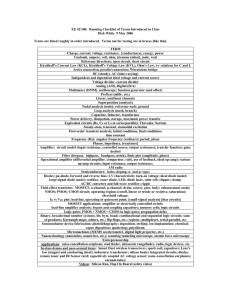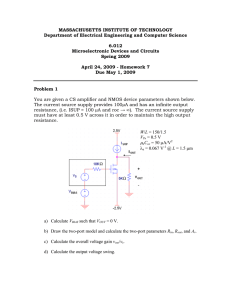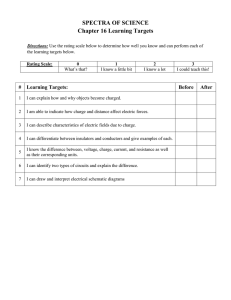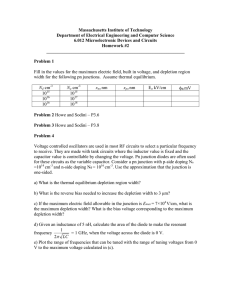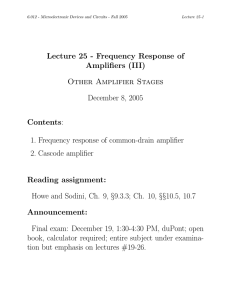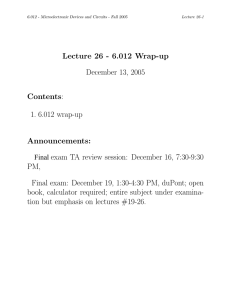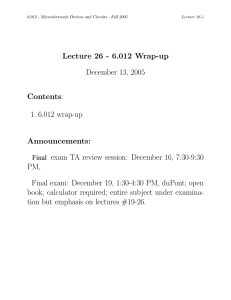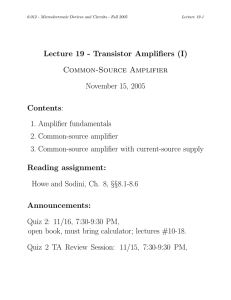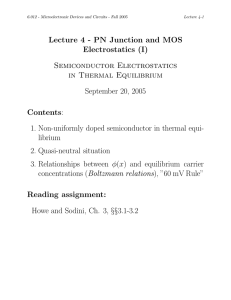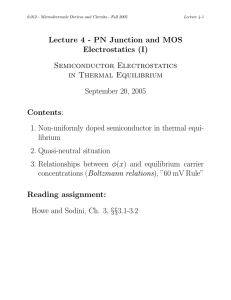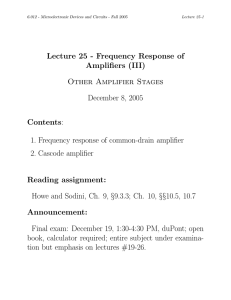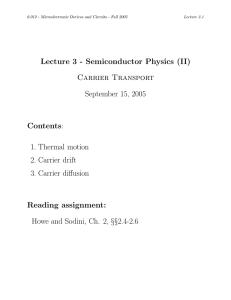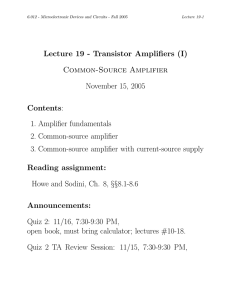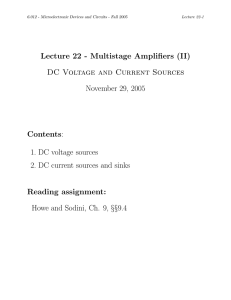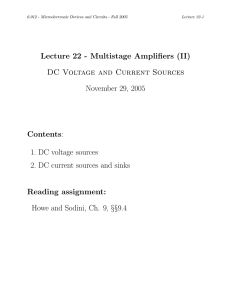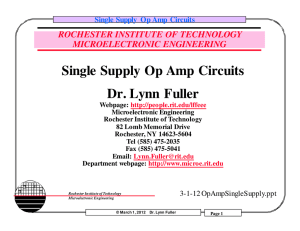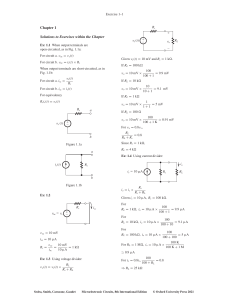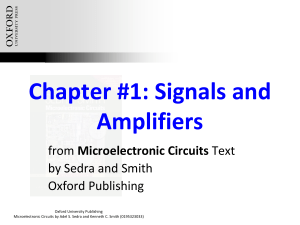Lecture Analyzing Outline •
advertisement
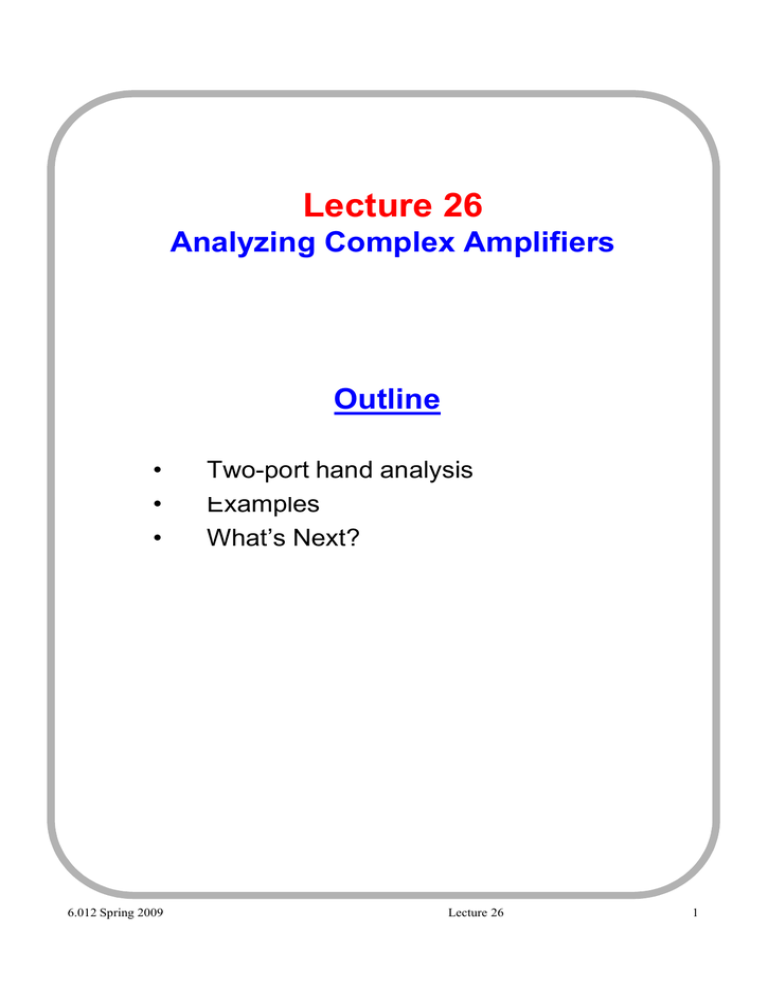
Lecture 26 Analyzing Complex Amplifiers Outline • • • 6.012 Spring 2009 Two­port hand analysis Examples What’s Next? Lecture 26 1 Multi­Stage Amplifier Analysis • Draw circuit such that signal stages and biasing devices can be easily identified. • Identify signal path and establish amplifier parameters. • Determine function of all other transistors­usually current or voltage sources. • Find high impedance nodes to estimate frequency response. 6.012 Spring 2009 Lecture 26 2 Can now understand more complex circuits? Examples: NMOS CD NMOS CS ­ PMOS CD 6.012 Spring 2009 Lecture 26 3 Can now understand more complex circuits? PNP CE PNP CC ­ PNP CE 6.012 Spring 2009 Lecture 26 4 BiCMOS Voltage Amplifier 5V M7 M7B M5 R 35 kΩ M6B Q4 M6 X 100 µA Q2B M8 M3 Q2 M9 Vs + − VBIAS + − vOUT M1 M10 Qualitative View • Identify signal path and establish amplifier parameters • CS­CB­CD­CC ­ Good voltage amplifier • Determine function of all other transistors­usually current or voltage sources • Find high impedance nodes to estimate frequency response 6.012 Spring 2009 Lecture 26 5 Small Signal Voltage Gain Cascode+Voltage Buffer • Cascode­CS­CB • Rin − −− > ∞ I2 RS Vs + − Iout + + Vgs1 gm1Vgs1 − ro1 −I2 1/gm2 βo2ro2 gm6ro6ro7 Vout − Rout = βo 2 ro2 gm6 ro6 ro7 v out2 v out Avo = = −g m1 βo2 ro2 g m6 ro6 ro7 ≈ vs vs • Voltage buffer CD­CC ( ) 1 1 gm4 + β (g + g ) o4 m3 mb3 1 (gm3 + gmb3) + vin3 + − + + vin3 + − rπ4 + βo4(RL ⎢⎢ro ⎢⎢roc) vin4 − − vin4 vout RL − CD − CC Rin′ → ∞ Rout = 6.012 Spring 2009 1 g m4 + Av ≈ 1 1 βo4 (g m3 + gmb3 ) Lecture 26 6 Frequency Response X β o2 ro2 roc Cµ 2 Cgd 6 Cdb6 + Ccs 2 Cgd 3 (1 − Av 3 )C gs 3 v out 2 v out Avo = = −gm1 (β o2 ro2 g m 6 ro6 ro7 ) ≈ vs vs 1 ω3dB = β r g r r o2 o2 m6 o6 o7 ( ) 1 (C + C + C + 1− A C + C + C gd6 gd3 vCgs3 gs3 db6 cs2 µ2 ( 6.012 Spring 2009 ) Lecture 26 7 Bode Plot V out V s ≈ gm1βo2ro2 1 ωunity ω 3dB 1 ω3dB = β r g r r o2 o2 m6 o6 o7 ( ω� log scale ) 1 (C + C + C + 1− A C + C + C gd6 gd3 vCgs3 gs3 db6 cs2 µ 2 ( ) ωunity = Avo * ω3dB = g m1 (Cµ 2 + Cgd6 + Cgd3 + (1 − AvCgs3 )Cgs3 + Cdb6 + Ccs2) 6.012 Spring 2009 Lecture 26 8 Large Signal DC Analysis • AssumeVBE = 0.7V VGS = 1.5V 5V 3.5 V M7B M7 M5 4.5 V 3.5 V 3.0 V R 35 kΩ 2.0 V M6B M6 100 µA 2.0 V Q2B 3.0 V 2.0 V 1.5 V M3 3.8 V 2.8 V 2.3 V Q2 Q4 vOUT RS vs M8 6.012 Spring 2009 + − M1 1.5 V M9 M10 + V − BIAS Lecture 26 9 Wrap­up of 6.012 6.012: Introductory subject to microelectronic devices and circuits • MICROELECTRONIC DEVICES – Semiconductor physics: electrons/holes and drift/diffusion, carrier concentration controlled by doping or electrostatically – Metal­oxide­semiconductor field­effect transistors (MOSFETs): drift of carriers in inversion layer – Bipolar junction transistors (BJTs): minority carrier diffusion • MICROELECTRONIC CIRCUITS • – Digital circuits (mainly CMOS): no static power dissipation; power ↓, delay ↓ & density ↑ as W & L↓ – Analog circuits (BJT and CMOS): fτ ↑ and gm ↑ as L ↓: however, Avomax ↓ as L ↓ Follow­on Courses • • • • • 6.152J — Microelectronics Processing Technology 6.720J — Integrated Microelectronic Devices 6.301 — Solid State Circuits 6.374 — Analysis and Design of Digital ICs 6.775 — Design of Analog MOS ICs 6.012 Spring 2009 Lecture 26 10 MIT OpenCourseWare http://ocw.mit.edu 6.012 Microelectronic Devices and Circuits Spring 2009 For information about citing these materials or our Terms of Use, visit: http://ocw.mit.edu/terms.
